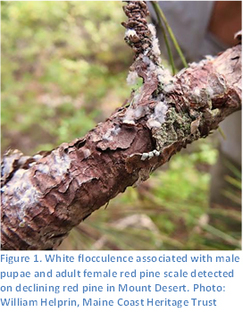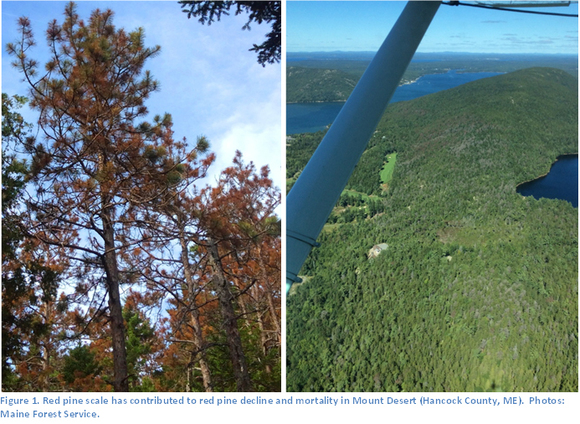Insect & Disease Conditions Update
Pest Alert: Red Pine Scale (Matsucoccus matsumurae) Detected in Hancock County, ME
 The invasive red pine scale (Matsucoccus matsumurae, formerly M. resinosae), also known as Japanese
pine bast scale was detected in Mount Desert, Hancock County, Maine earlier
this month. The original sample was
submitted to the Lab by a gardener who
had observed and was concerned about the die-off of more than 100 red pines (Pinus resinosa) along Sargeant Drive in Mount Desert. She had noted that the intermixed pitch pine
were unaffected. In a follow-up visit to a forested stand in Northeast Harbor,
the scale was readily detected once live red pines were encountered.
Red pine scale is native to Japan. In the United States, it was first detected
in 1946 in Easton, CT. It is considered
a serious pest in its introduced range in China, Korea, Europe and the United
States. Where it is found in the United
States, it is one of the most significant pests of red pine. It does not affect other pine species native
to Maine.
Little is yet
known about red pine scale occurrence in Maine. It appears the insect is well established in the area around Northeast
Harbor in Mount Desert and it has contributed to significant red pine mortality
there. MFS staff have been responding to
concerns regarding red pine decline and mortality in that area for a number of
years. This is the first time the insect
has been encountered on submitted or gathered samples and in field visits. However, it is not likely that this is a new
introduction.
Red pine scale seems to be relatively intolerant of cold winter temperatures, evidenced by its slow northward expansion and results of a single study on cold-tolerance in the 1950’s. It is possible the insect is established elsewhere in Maine, especially in warm, coastal regions (likely Plant Hardiness Zone 5b and warmer
http://planthardiness.ars.usda.gov/PHZMWeb/Images/300dpi/ME.jpg).
|
The insect is known to spread on wind. Scales may also hitchhike on birds and
mammals, similarly to hemlock woolly adelgid. There is a low risk of spread during winter
months, when scale is settled on the host. Longer dead material also does not pose a risk of spread. During the spring through fall when eggs and
mobile nymphs and adults are present there is some risk of picking up the
insect on clothing and machinery when working in infested stands or trees as
well as moving the insect on cut material. Live host material is the highest risk product for transport of the
insect. When possible, work in infested trees
should take place in the winter, when the red pine scale is attached to the
host. |
|
 |
 Significant disease symptoms are also
observed in red pine in Mount Desert and throughout Maine. Principal agents are two shoot blights, Sirococcus conigenus and Diplodia pinea. These do not have the same climatic
limitations to their distribution that red pine scale appears to have, and are
found in hosts from the coast, northward. They are favored by wet conditions in spring and early summer and are of
increasing concern in the state.
If you suspect you have found damage
from red pine scale outside of Northeast Harbor, please report it to the Maine
Forest Service Insect and Disease Lab.
More information on red pine scale can
be found at: www.maine.gov/forestpests#rps.
More information
on Sirococcus shoot blight can be
found at: http://www.maine.gov/dacf/mfs/forest_health/diseases/sirococcus_shoot_blight.htm
Pest Alert: Red Pine Scale. Sept. 2014. Maine Department of Agriculture
Conservation and Forestry, Maine Forest Service
Red Pine Scale Contact: Allison
Kanoti, allison.m.kanoti@maine.gov or (207) 287-3147
Shoot Blight Contact: William
Ostrofsky, bill.ostrofsky@maine.gov or (207) 287-3008
| 



